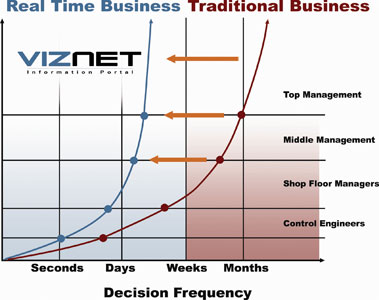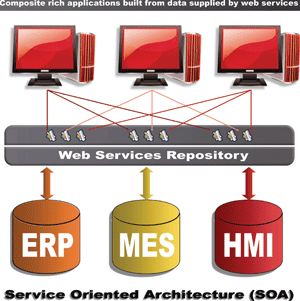

What is SOA and what impact does it have in the control industry?
As with all new technological fashions, SOA promises to deliver better, faster, cheaper IT support than was possible before it arrived. In this article we take a look at what SOA really is, how it will benefit you and your business, what its impact will be and what you should look out for when you begin with the rollout of SOA.
Realtime business
At the shop-floor and control room level we are used to the realtime world but in general as soon as you move above the scada/HMI level the IT world moves into the transactional world of databases. Manufacturing execution systems (MES), laboratory information management systems (LIMS), enterprise resource planning (ERP) are all essentially in this domain. The challenge business has always faced is: how do you build a realtime business out of the transactional world so that managers can make informed decisions in realtime as opposed to making decisions based on historical reports and data that looks backwards?
The concept of the realtime enterprise is an attempt to compress and reduce reporting cycles and to make data from all systems available for exposing key performance indicators (KPIs) and define metrics to decision makers across an organisation with a view to exposing problems earlier. This in turn will lead to improved operational efficiency through quicker corrective actions and decisions.

Standards and SOA
OPC
In the instrumentation and control world OLE for process control (OPC) made its way onto the scene in the late ’90s as a way of allowing interoperability between systems.
If users have an OPC server then any OPC client would be able to access the data and have it available for processing; hence OPC was a standard way of both exposing and accessing data between different software products.
Why not OPC? OPC was designed with the process control markets needs in mind. Single pieces of realtime data exposed in a defined way so that different applications can inter-operate and exchange data reliably and seamlessly.
Web services
Web services was developed as a way of allowing systems to expose data in a loosely coupled object oriented fashion to offer a standard way of interfacing with and consuming the service or data from the application.
The concept of web-services was borne out of web-based applications, enabling others to use the service without having to either embed code or bind themselves to a particular provider of information.
The traditional way of implementing the solution would be to purchase the software, install it on site, get trained, and use the product. New releases required upgrading the software on site – sometimes at great cost.
Using web services instead it is possible for suppliers to offer their advanced control algorithms to the entire world. They host the main application at their offices, and write code to expose the variables needed to run the algorithm via a web service; users then take the necessary variables from their plant and put them into the algorithm. The results follow, which in turn allows the necessary changes to set-points in the process.
The advantage is that anyone, anywhere in the world can use these services, which may be pay-per-use or subscription based with the maintenance headaches removed.

The move to SOA
Once the basic principles are understood, SOA is really just an IT architectural approach that extends the thinking to software as a service on a web-based delivery platform. What SOA offers is a way of structuring software components to get additional benefits in a standardised way – without necessarily providing anything unique or additional.
Dave Wibberley, managing director of Adroit Technologies says, “Organisations start with an application silo architecture comprised of individual applications. They then move through standardised architecture involving more centralisation. Finally, they end-up with a rationalised data architecture that includes the standardisation of data and processes with a view to ultimately ending up with a services oriented architecture.”
In other words an SOA is to have all the necessary applications used within an organisation implement web service interfaces or to use product offerings such as .Net visualisation platform, VIZNET, and TIBCO to create an SOA layer.
“People need to realise that SOA will not magically solve integration issues or suddenly allow companies to re-use components of software, there are numerous underlying design decisions and imperatives that have to first be considered,” says Wibberley. “The general feeling amongst IT practitioners is that although the return on investments is difficult to quantify, companies that implement SOA will generally see the returns after the second or third project.”
Adroit Technologies’ technical director Mike Lamusse points out, “We have already implemented a web service interface to Adroit and VIZNET. It is structured on an SOA approach so we, as vendors, are SOA ready.
“In addition our VIZNET product is ideally suited to building a composite portal around a company’s SOA. This is because it can auto-discover web services and integrates into other disparate and legacy systems through standards such as object linking and embedding database (OLEDB) and OPC making it a very complementary application,” Concludes Lamusse.
For more information contact Dave Wibberly, Adroit Technologies, +27 (0)11 658 8100, [email protected], www.adroit.co.za
| Tel: | +27 11 658 8100 |
| Email: | [email protected] |
| www: | www.adroitscada.com |
| Articles: | More information and articles about Adroit Technologies |

© Technews Publishing (Pty) Ltd | All Rights Reserved